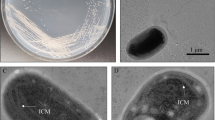Abstract
From an uranium mine three strains of rodshaped, mesophilic, chemolithoautotrophic bacteria were isolated. They grow by oxidation of H2S, galena (PbS) and H2. Anglesite (PbSO4) is formed from galena. No ferrous iron is oxidized by the isolates. They grow between pH 4 and 6.5 at temperatures of about 9 to 41°C (optimum around 27°C). The G+C content of the DNA is around 66 mol %. Based on their ability to oxidize sulfur compounds, the new organisms belong to the genus Thiobacillus. No significant homology with Thiobacillus ferrooxidans and Thiobacillus cuprinus was detected by DNA-DNA hybridization. Therefore the new isolates represent a new species within the genus Thiobacillus. Based on the unusual growth on galena, we name the new species Thiobacillus plumbophilus (type strain Gro 7; DSM 6690).
Similar content being viewed by others
References
Baalsrud K, Baalsrud KS (1954) Studies on Thiobacillus denitrificans. Arch Mikrobiol 20: 34–62
Birnstiel ML, Sells BH, Purdom IF (1972) Kinetic complexity of RNA molecules. J Mol Biol 63: 21–39
Colmer AR, Hinkle ME (1947) The role of microorganisms in acid mine drainage: a preliminary report. Science 106: 253–256
Drobner E, Huber H, Stetter KO (1990) Thiobacillus ferrooxidans, a faccultative hydrogen oxidizer. Appl Environ Microbiol 56: 2922–2923
Gillespie S, Gillespie GD (1971) Ribonucleic acid — deoxyribonucleic acid hybridization in aqueous solutions and in solutions containing formamide. Biochem J 125: 481–487
Guay R, Silver M (1985) Thiobacillus acidophilus sp. nov., isolation and some physiological characteristics. Can J Microbiol 21: 281–288
Huber H, Huber G, Stetter KO (1985) A modified DAPI fluorescence staining procedure suitable for the visualization of lithotrophic bacteria. Syst Appl Microbiol 6: 105–106
Huber G, Huber H, Stetter KO (1986) Isolation and characterization of new metal-mobilizing bacteria. Biotechnol Bioeng Symp 16: 239–251
Huber H, Stetter KO (1989) Thiobacillus prosperus sp. nov., represents a new group of halotolerant metal-mobilizing bacteria isolated from a marine geothermal field. Arch Microbiol 151: 479–485
Huber H, Stetter KO (1990) Thiobacillus cuprinus sp. nov., a novel facultatively organotrophic metal-mobilizing bacterium. Appl Environ Microbiol 56: 315–322
Katayama-Fujimura Y, Tsuzaki N, Kuraishi H (1982) Ubiquinone, fatty acid and DNA base composition determination as a guide to the taxonomy of the genus Thiobacillus. J Gen Microbiol 128: 1599–1611
Kelly DP (1988) Evolution of the understanding of the microbiology and biochemistry of the mineral leaching habitat. In: Norris PR, Kelly DP (eds) Biohydrometallurgy. Science and technology letters. Kew, Surrey, England, pp 3–14
Kelly RB, Cozzarelli NR, Deutscher MP, Lehmann JR, Kornberg A (1970) Enzymatic synthesis of deoxynucleic acid by polymerase at single strand break. J Biol Chem 245: 39–45
Kingma JG, Silver M (1980) Growth of iron-oxidizing Thiobacilli in the presence of chalcopyrite and galena. Appl Environ Microbiol 39: 635–641
König H (1984) Isolation and characterization of Methanobacterium uliginosum sp. nov. from a marshy soil. Can J Microbiol 30: 1477–1481
Marmur J, Doty P (1962) Determination of the base composition of deoxyribonucleic acid from its thermal denaturation temperature. J Mol Biol 5: 109–118
Schink B, Schlegel HG (1979) The membrane-bound hydrogenase of Alcaligenes eutrophus. I. Solubilization, purification, and biochemical properties. Biochim Biophys Acta 567: 315–324
Torma AE, Sakaguchi H (1978) Relation between the solubility product and the rate of metal sulfide oxidation by Thiobacillus ferrooxidans. J Ferment Technol 56: 173–178
Silverman MP, Lundgren DG (1959) Studies on the chemoautotrophic iron bacterium Ferrobacillus ferrooxidans. I. An improved medium and a harvesting procedure for securing high cell yields. J Bacteriol 77: 642–647
Vishniac WV (1974) The genus Thiobacillus. In: Buchanan RE, Gibbons NE (eds) Bergey's manual of determinative bacteriology, 8th edn. Williams and Willkins, Baltimore, pp 456–461
Wildgreber G, Thomm M, König H, Ober K, Ricchiuto T, Stetter KO (1982) Methanoplanus limicola, a plate-shaped methanogen representing a novel family, the Methanoplanaceae. Arch Microbiol 132: 31–36
Williams WJ (1979) Handbook of anion determination. Butterworths, London, pp 570–572
Zillig W, Stetter KO, Wunderl S, Schulz W, Priess H, Scholz I (1980) The Sulfolobus-“Caldariella” group: taxonomy on the basis of the structure of DNA-dependent RNA polymerases. Arch Microbiol 125: 259–269
Author information
Authors and Affiliations
Rights and permissions
About this article
Cite this article
Drobner, E., Huber, H., Rachel, R. et al. Thiobacillus plumbophilus spec. nov., a novel galena and hydrogen oxidizer. Arch. Microbiol. 157, 213–217 (1992). https://doi.org/10.1007/BF00245152
Received:
Accepted:
Issue Date:
DOI: https://doi.org/10.1007/BF00245152




